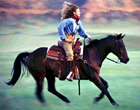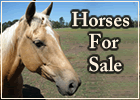

Horse Advice
Hello Ed,
Hope your horse clinics are doing well. Your newsletter keeps us informed about your horse adventures. My horse friends and I are still riding whenever we can. Seems like this year the weather in Indiana was not great for riding.I was wondering if you could offer me some horse advice and I would be happy to pay you for your time. I am still riding my 8 year old Paint gelding that I have had since he was two. Apache has his own personality, different from any that I have had experience with. We trail ride western and a lot of the time he is well behaved. He is energetic, but is very light and responsive to reining, stopping, backing, side passing, leg cues, etc. He is familiar with the groundwork games, but I usually just get on and ride. I use a wide fleece lined, leather nose band mild hackamore with a curb chain on him, but rarely have to engage it for any control, can ride with a loose rein. When using other bits on him snaffles or tom thumb types, in the past he constantly would chew the bit and bang it around in his mouth (teeth are vet checked and fine, but Apache appears to have a thick tongue). Also, those mouthpieces would sometimes rub or pinch his lips on the sides. His behavior improved with the hackamore and he relaxed a great deal. But now, especially when other horses ride with us or he is not in the lead, he bites and grabs at the reins, and holds them in his mouth. He acts the best when I ride him alone or he is in the lead and even way ahead of the other horses. He also will toss his head around if he is the second horse, full of himself and sometimes hop up and down. We do practice riding in different positions, so he is not always first. Should, I make him do this or just let him be happy in the lead? I do ride him a lot more alone than with others.
Besides the issues with the bit and being ridden with other horses, once in a while when Apache is in the lead he will stop and resist going forward and backup, with a whirl or slight rear. He usually can be reined around and he will walk on. But sometimes it happens in a not so safe place, on an incline or narrow path and also no space to work with him at that time. I don't know if putting him back in a bit would help with grabbing at the reins to chew or the resistance issue. I prefer a bit with a curb and have been looking at the Myler combo bit that works off the nose, curb, poll, and bit. But not sure to go with a level 2 or 3 mouthpiece level for him.He lately also has developed issues when I tighten the girth and when I first mount he wants to jump around. I have to let him stand quite awhile and slowly tighten it in steps, then walk him around before getting on. I am using a Professional Choice neoprene backed straight girth. He is a thin skinned sensitive horse.
Other than these issues, Apache is a great horse! :) He is fun to ride, a challenge, comfortable, and very handsome. I work at making him a calm trail horse, but I do think under the wrong conditions such as other riders taking off or a frightening spook, he could get worked up and rear or buck, if not reined in. I do feel that he may sometimes get bored with trail riding and he might have been better suited as an athletic horse, reining, racing, team penning, etc., with a job to do.
All of the above issues seem to happen when other horses are around. Apache gets along with my other 12 year old gelding in the pasture, but these issues can happen some when riding with the two of them together too. He is just much more attentive when ridden by himself. I would appreciated any thoughts or tips that you might have about him and how to correct these issues.Thanks for any suggestions,
Sonya
Hi Sonya,
As far as your horse issues, first I would be sure all medical, dental and pain issues are treated and eliminated. Because of the head tossing, I highly recommend finding a real Equine Dentist. Vets just do not receive the extensive training to do a thorough job of dental treatment. For a healthy mouth and a happy horse much more is required than floating with a hand rasp. The horse should be sedated and the dentist should use a spectalum and power tools to properly align the molar arcade slopes and ramps, establish a bit seat and insure that the incisors meet evenly. If this was not done then your horse has not received an adequate dental treatment which can certainly result in chewing, busy mouth, aggravation, rearing and head tossing.
Girth tightening issues can be a result of sore back, dislocated ribs or improperly functioning kidneys or liver. I recommend having your horse examined by a Vet, Equine Osteopath, Equine Massage Therapist and/or and Equine Chiropractor.
After the dental treatment and other physical or pain issues are addressed, I would try to switch him back to a snaffle bit. The mechanical hackamore you are using works on a principal of leverage between the nose bone and the bottom jaw. The head tossing and rein chewing may be a protest to the pain of the hackamore squeezing down on him. With the snaffle bit you have complete control through lateral flexion without inflicting any pain. Are you familiar with the use of the snaffle for hindquarter disengagement and the "one rein stop"? I use a D ring, pinchless snaffle that will not rub or pinch his lips or tongue. You may see it at http://www.eddabney.com/shop/item.asp?itemid=5
Just because he likes riding in the lead doesn't mean you have to let him do that all the time. A well trained horse should behave well no matter where he is ridden in the line. He needs to trust your leadership and respect you more. This begins on the ground. I would never quit doing a full ground work session with him before every ride. You should be able to complete your "pre-ride checklist" of exercises in 10 or 15 minutes and mount up with a more respectful, calm and trusting horse and with more confidence in yourself that the ride will go well.
Being "full of himself" and getting "worked up" could be caused by his diet and turn-out as well. The ideal situation would be 24/7 turn-out, plenty of good quality hay (no alfalfa) and very little or no grain.
As far as riding with other horses in the lead, start with a riding partner who will help you with training and go on short rides away from the barn then return before your horse gets upset. Gradually make the rides longer as he becomes more comfortable following the other horse. Turn him in a small circle with one rein anytime he crowds the horse in front of him in order to teach him to maintain a respectful and safe interval distance. Do lots of stop and go in order to build in a very solid "go forward" cue for when he balks.
When he balks in a precarious place on the trail, just sit and relax. Don't ask him to go forward but keep him facing forward. Prevent him from turning by holding one rein or the other but don't pull back on the reins. When he is calm and bored with standing still then very quietly ask him to go forward.
As far as cinchyness, that can also be a pain issue which should be investigated. After that, you should just lightly snug up the cinch when you saddle up then do your ground exercises saddled. Between every couple of exercises you should slightly tighten the cinch. This way it is tightened gradually over a period of time as your horse settles in to the saddle.
I recommend the Thinline cinch. http://www.thinlineinc.com/store/cart.php?m=product_detail&p=54 Here is my testimony from their web site:
Ed Dabney, well known clinician, had this to say about the ThinLine Cinch:
"After using the ThinLine cinch for several months on many different horses in varied terrain at all gaits I am happy to say I am very pleased with the cinch. It is an excellent design, attractive, durable, easy to clean and most importantly it is good for my horse. With the ThinLine open cell foam lining the cinch is breathable and non-chaffing. It evenly distributes the cinch pressure and holds the saddle securely in place. I've had no girth galls or skin fungus in the cinch area since the ThinLine foam is antifungal. The ThinLine cinch keeps our horses cool, comfortable and healthy."
As you incorporate these suggestions, please let me know how things are progressing with you and Apache.
Enjoy the Journey,

Ed Dabney is an internationally acclaimed clinician, presenting horsemanship and riding clinics all over the US and in Europe. In 2007, Ed was named Champion of the East Coast Trainer Challenge Series by Equine Extravaganza. Ed was honored to have been selected by the University of Georgia to teach their senior level Young Horse Training course.
His training articles have appeared in many major national magazines. Ed produces instructional videos and the “Gentle Horsemanship” TV program which has been seen on RFD-TV.
Ed's blending of natural horsemanship and classical equitation has made an indelible mark with students all across the United States and now also in Europe, drawing the attention of serious riders searching for the lightest touch and the deepest connection with their horses irrespective of breed or discipline.


